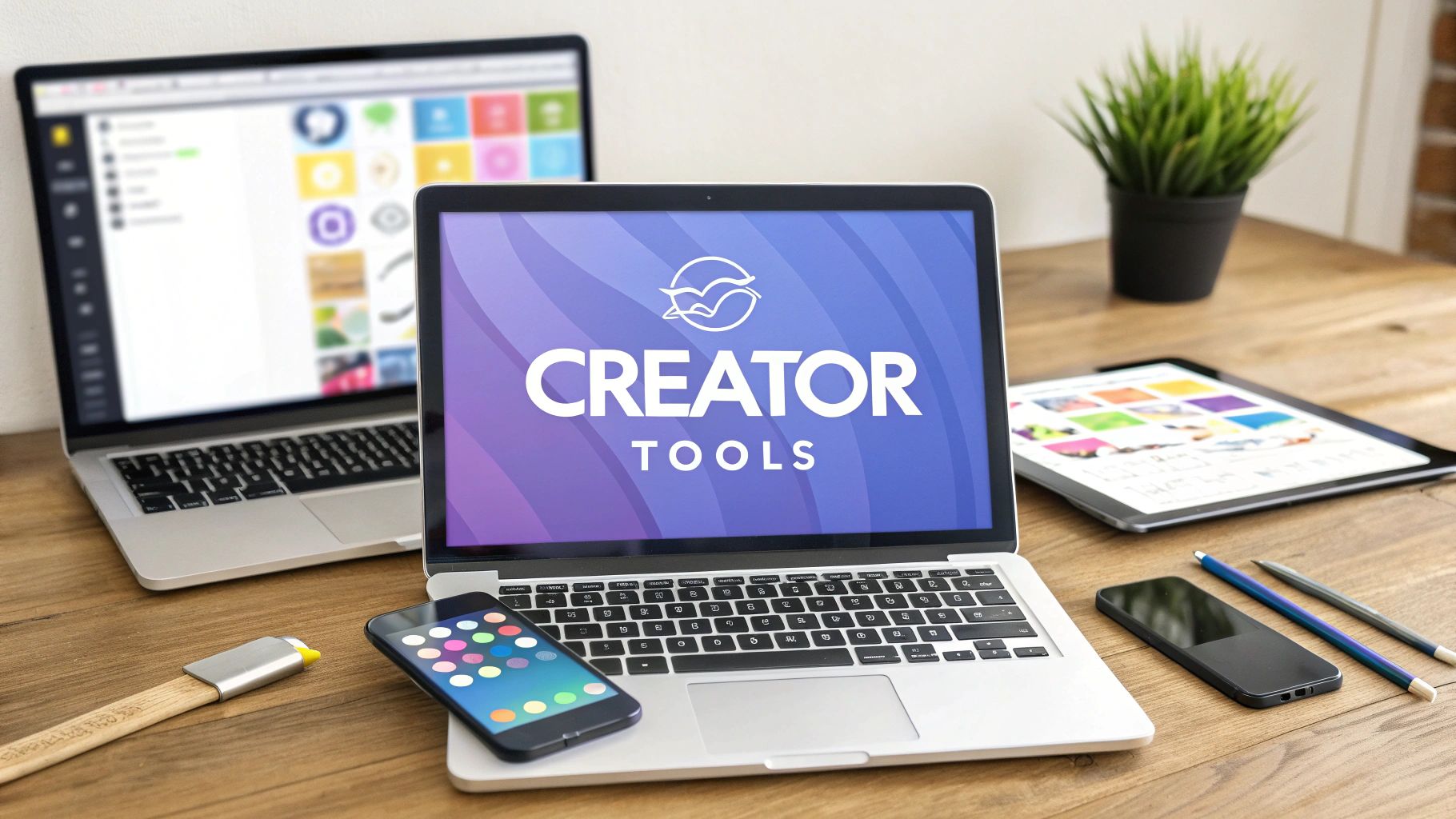Why User-Generated Content Ads Feel Different
Imagine scrolling through Instagram. You see two ads for the same hiking boots. One features a glamorous model posing on a mountaintop. The other shows a real person talking about how these boots carried them through their latest backpacking adventure. Which ad feels more genuine? That's the magic of user-generated content (UGC) ads. They create a connection that polished, corporate advertising struggles to achieve.
This isn't just a fleeting fad; it's a shift in how we absorb information. We're more skeptical of traditional ads, seeking validation from people we can relate to. Think about it – are you swayed by a celebrity endorsement or a friend’s rave review? UGC ads leverage this human instinct for social proof. They feel less like advertisements and more like authentic recommendations from one hiker to another.
This authenticity translates into powerful results. Studies reveal UGC ads boost conversion rates by a staggering 29% compared to traditional methods. This makes sense considering 92% of consumers trust UGC more than traditional ads. The sway of UGC on purchases is significant, with 79% of people saying it impacts their buying decisions. Real people, sharing real stories—it's a potent combination. For a deeper dive into these numbers, check out GoViral Global. Discover more insights on UGC performance here.
The Power of Real Voices
Smart brands understand their customers are their greatest asset. They’ve moved from broadcasting at their audience to amplifying the voices of their audience. This creates a cycle of positive reinforcement. Customers feel valued, and potential buyers see real enthusiasm, more impactful than any marketing slogan.
This screenshot from GoViral Global showcases the various services utilizing user-generated content, indicating the wide-spread demand for authentic customer voices. It highlights how UGC is becoming an essential marketing strategy across many industries.
Why UGC Builds Trust
UGC ads resonate because they are grounded in actual experiences. They connect with our inherent desire for authenticity and validation. We see ourselves in these stories, creating a sense of trust that traditional ads just can't match. This leads to better engagement, higher conversions, and a stronger brand community. Instead of being an interruption, UGC ads become a valuable part of the online conversation, offering genuine insights that feel like advice from a trusted friend.
The Trust Factor: Why Your Brain Believes Real Customers

Think about the last time you picked a new restaurant. Did a glossy ad convince you, or was it a friend's offhand suggestion? More likely than not, the personal story won out. That's the core idea behind user-generated content (UGC) ads. They speak to our fundamental need for social proof. When we're unsure, we naturally turn to others, especially those we see as being like us.
This effect gets even stronger when the content isn't from polished influencers or brand ambassadors, but from regular people. UGC ads feel genuine because they are genuine. They're not carefully constructed marketing pitches; they're glimpses into real experiences. A photo of someone using a product in their everyday life, for example, feels much more real than a perfectly staged studio shot.
The Psychology of Authenticity
This trust isn't an accident; it's wired into us. Our brains are drawn to what feels unfiltered and natural–what we call authenticity bias. We're inclined to believe information that feels real, even if it contradicts information from supposedly authoritative sources. Peer influence also plays a big part. We're more likely to follow the lead of our social groups, both online and off. Want to learn more about how this works? Learn more in our article about user-generated content benefits.
This all leads to stronger emotional connections with UGC ads. Seeing someone's genuine enthusiasm for a product can make us feel that same excitement. This emotional resonance builds trust in a way traditional advertising just can't match. Think of it like getting a hiking trail recommendation from a fellow hiker – their excitement is infectious.
To illustrate the difference between traditional ads and UGC ads, let's take a look at a comparison table:
Traditional Ads vs User Generated Content Ads: Trust and Engagement Comparison
| Metric | Traditional Ads | UGC Ads | Improvement |
|---|---|---|---|
| Consumer Trust | Lower | Higher | Significant increase |
| Engagement Rate | Often low | Typically high | Can be substantial |
| Conversion Rate | Can be low | Potentially much higher | Notable potential gains |
This table highlights the key advantages of UGC ads. They foster higher trust, leading to better engagement and, ultimately, more conversions.
Building Trust Through Real Stories
Smart marketers understand these psychological principles. They know that building trust goes beyond slick images and catchy slogans. It’s about tapping into our human need for connection and authenticity. By showing real customer experiences, UGC ads offer compelling social proof that resonates deeply. This builds genuine connection, trust, and loyalty that outperforms traditional advertising, especially in a market flooded with impersonal marketing. UGC cuts through the noise and speaks directly to what consumers want, making it incredibly powerful.
Finding Your Content Goldmine: UGC Types That Actually Work
Not all user-generated content (UGC) is created equal. Some UGC shines like gold, while other pieces… well, let's just say they don't quite hit the mark. Knowing which types of UGC drive real results is key to a winning UGC ads strategy. It’s a bit like panning for gold – you need the right tools and the right location to strike it rich. Some customers create stunning visuals, others write compelling reviews, and some are natural storytellers on video.

This Instagram feed is a perfect example. See the mix of photos, videos, and stories? That’s the diverse power of UGC waiting to be harnessed for authentic brand engagement.
Tapping Into the UGC Vein: Content Formats That Shine
Let's explore the different UGC formats that can make your ads sparkle. Think of this as a deep dive into the treasure chest of content, from casual social media posts to structured reviews.
- Social Media Posts: Think of those spontaneous bursts of enthusiasm on social media. A simple photo of someone enjoying your product can be surprisingly effective.
- Images: High-quality customer photos are like gold nuggets. Imagine before-and-after photos for a beauty product or a customer using your software in a real-world setting.
- Videos: Authentic video testimonials or customer-created how-to videos can have a huge impact. Seeing is believing, right?
- Reviews: Detailed customer reviews build trust and credibility. Think of them as little nuggets of social proof, addressing common concerns and swaying potential buyers.
- Blog Posts: Sometimes, a passionate customer will write a blog post about their experience. These in-depth reviews offer a unique perspective and can reach a broader audience.
- Stories: These fleeting glimpses into real-time experiences on platforms like Instagram and Snapchat offer a raw and unfiltered look at how people use your product.
Matching Content to Objectives: A Strategic Approach
Just like a prospector chooses the right tool for the job, you need to select the right UGC for your marketing goals. Different UGC works best at different stages of the customer journey. A testimonial video might be perfect for someone on the fence, while a striking customer photo might spark initial interest.
- Awareness: Eye-catching visuals and engaging stories are your best bet for grabbing attention. Think Instagram and TikTok.
- Consideration: Detailed reviews and testimonials build trust and help potential customers evaluate their options.
- Decision: Videos showcasing product benefits and addressing concerns can give customers that final nudge towards purchase.
Real-World Examples: UGC in Action
So, how are brands actually using these different UGC types? Let's take a look at some real-world examples.
- Beauty Brands: Before-and-after photos are a game-changer, showcasing product effectiveness in a way that staged photos simply can't.
- Food Companies: Customer cooking videos using your product are engaging and relatable, transforming everyday moments into compelling ads.
- Service Businesses: Customer success stories are powerful testimonials that resonate with prospects facing similar challenges.
By understanding these different content types and how they align with your objectives, you can unlock the true power of UGC. Creating ads that resonate with your audience isn’t about luck; it’s about a strategic approach to user-generated content. That's what sets successful campaigns apart.
Building Your Content Creation Community

Successful user-generated content ads (UGC ads) aren't about stumbling upon random content. They're about building real relationships with your customers. Think of it like cultivating a garden – you need to nurture it to see it flourish. Your customers are your partners in this content creation journey, not just passive observers.
Nurturing Authentic Engagement
The most innovative brands understand that creating an environment where content creation feels natural is key. It's not about forcing participation or offering constant incentives. It's about fostering genuine engagement. Imagine how a memorable unboxing experience can naturally lead a customer to share their excitement online. Or think about Apple's #ShotoniPhone hashtag – it's a simple way to encourage users to showcase their photography skills. Looking for ways to optimize your strategy? Check out Sprello's guide on creative testing.
Another vital step is designing experiences that actively encourage sharing. This could be something as straightforward as a clear call to action on your packaging, inviting customers to post photos. Or perhaps a contest that inspires creative submissions. The goal is to make participation feel easy and enjoyable.
Identifying Your Content Champions
Every community has its core members – those who are truly invested. For your brand, these are your content champions. They're the customers who regularly interact with your brand, leave reviews, and share their experiences on social media. Identifying them is the first step in building a strong content creation community.
Understanding what motivates these individuals is equally important. Some might be driven by the desire to connect with others, while others might be motivated by recognition or exclusive perks. By understanding their motivations, you can refine your engagement strategies for greater impact.
Building Sustainable Systems
Creating a thriving community isn't a one-time project. It requires ongoing support and the right systems in place. This means having a streamlined way to encourage, collect, and curate user submissions. Consider these options:
- Creating a dedicated hashtag: This acts as a central hub for all user-generated content related to your brand.
- Developing a content submission portal: This makes it simple for customers to share their creations directly with you.
- Implementing a content moderation process: This ensures all content aligns with your brand's guidelines.
Maintaining Authenticity and Guidance
While customer creativity is invaluable, brands also need to maintain a degree of control over their messaging. It's a balancing act – providing guidance while preserving the authentic voice that makes UGC ads so compelling.
Offering content creation prompts or themes is a great way to inspire customer contributions. Providing clear guidelines on content format and style can also ensure brand consistency without stifling creativity. By nurturing these relationships and setting clear expectations, brands create a mutually beneficial situation for both the company and its customers. The result? A vibrant ecosystem of authentic content that powers truly effective user-generated content ads.
Platform Mastery: Where Your UGC Ads Actually Thrive

The infographic above gives us a snapshot of how User-Generated Content (UGC) ads perform. It compares average engagement, conversion rates, and return on ad spend for UGC against traditional ads. Notice how UGC consistently outperforms traditional methods? This highlights the impact of authentic customer voices and suggests that integrating UGC into your advertising strategy can boost both engagement and ROI.
Each social media platform has its own unique vibe and audience expectations. What works on TikTok might fall flat on LinkedIn. Understanding these nuances is key to UGC ad success. Think of it like choosing the right outfit for different occasions. You wouldn't wear a ballgown to the gym, right?
Why Platform Matters
The rise of social media has drastically changed how we consume and utilize UGC in advertising. Platforms like Instagram, TikTok, and YouTube are now central hubs for UGC. Instagram posts with UGC are projected to see 70% more engagement than standard brand posts by 2025. On TikTok, UGC is anticipated to be 22% more effective than brand-created content, a testament to its influence on consumer behavior. YouTube remains a dominant force as well, with UGC videos garnering almost ten times the views of branded content. For a deeper dive into these platform dynamics, discover more insights on UGC trends.
Tailoring UGC to Each Platform
This means brands need to tailor their UGC ad strategies to each platform. Authentic, slightly unpolished content often performs well on TikTok, embracing a spontaneous feel. Instagram, however, tends to favor more curated and visually appealing user content. LinkedIn, being a professional networking platform, prefers UGC that showcases expertise and thought leadership.
Respecting the Ecosystem
The trick is to stay true to your brand’s core message while respecting each platform's individual ecosystem. Imagine a brand selling outdoor gear. On Instagram, they might showcase breathtaking customer photos from hiking adventures. On TikTok, they could share short, engaging videos of people using their gear in everyday life. On LinkedIn, they might highlight customer testimonials about how the gear helped them achieve a professional goal, such as leading a team-building activity.
To help visualize this further, let's take a look at the table below:
To understand how to best leverage UGC on each platform, let's examine some platform-specific best practices and performance metrics. The following table provides a general overview, but remember that trends and engagement rates can fluctuate.
Platform-Specific UGC Performance Metrics and Best Practices
| Platform | Best UGC Format | Average Engagement Rate | Key Success Factors |
|---|---|---|---|
| High-quality images & videos, Stories, Reels | Varies greatly, aim for 1-3% | Visually appealing content, relevant hashtags, influencer marketing | |
| TikTok | Short-form videos, trending sounds & challenges | Can reach 10% or higher | Authenticity, humor, engaging with community |
| YouTube | Longer-form videos, tutorials, reviews | Varies, focus on watch time | Informative content, strong storytelling, community engagement |
| Text posts, images, videos, live streams | Generally lower than other platforms | Community building, targeting specific groups, engaging with comments | |
| Text posts, articles, videos related to professional topics | Lower engagement, focus on quality leads | Thought leadership, professional insights, industry relevance |
This table provides a starting point for your UGC strategy. Remember to continually analyze your own data and adjust your approach accordingly. What works best for one brand might not work for another, so experimentation is essential.
Optimizing for Algorithms and User Behavior
By understanding platform-specific algorithms and user behaviors, you can ensure your authentic customer stories connect with the right people in the right format at the right time. This involves optimizing your UGC ads for each platform's search and discovery features. For instance, using relevant hashtags on Instagram and responding to comments on Facebook can significantly broaden your reach. Also, understanding the ideal video length and style for each platform – short and dynamic for TikTok, longer and more polished for YouTube – can maximize engagement. This tailored approach ensures your UGC resonates with the particular audience of each platform, driving stronger outcomes.
Protecting Everyone: The Legal Side of UGC Ads
Let's be upfront: just because someone mentions your brand online doesn't mean you have a free pass to plaster their words all over your user-generated content (UGC) ads. It's like that saying, "Finders keepers, losers weepers" – it just doesn't apply in the grown-up world of intellectual property. You need to ask first.
Understanding Rights and Permissions
The legal stuff around UGC might seem like a tangled mess, but it's really just about respect and common sense. Think of it like this: when someone creates content, they own it, plain and simple. That’s their intellectual property. Using it for your advertising requires a green light from them – their explicit permission.
Getting permission isn't just a nicety; it's your shield against legal headaches. Imagine the fallout from using someone's photos without asking – fines, a damaged reputation, and upset customers. A simple "Can I use this?" goes a long way.
Navigating the Legal Maze: Key Considerations
- Explicit Consent: Don't hint or assume. Ask directly. "May we use your photo in our ad?" Clear as day.
- Written Agreements: A handshake is nice, but a written agreement is a safety net for everyone. It spells out how the content can be used, if there's any payment involved, and other important details. Think of it like a contract for borrowing that proverbial lawnmower.
- Clear Terms of Use: Make sure your website and social media pages have clear guidelines about UGC. This sets the ground rules and prevents misunderstandings.
- Platform Policies: Every platform, like Instagram and TikTok, has its own rules. Know them. Follow them.
Learning From the Pros and Cons: Real-World Cases
Let's learn from those who've been there. Some brands have mastered the art of UGC rights management, while others have stumbled. Their experiences are goldmines of practical wisdom. For instance, some have built smooth permission processes right into their marketing, making it easy to get the okay while building good relationships with creators.
Others, unfortunately, have skipped the asking part, assuming permission or using content without giving credit. These cautionary tales are reminders of why proactive rights management is so important.
Streamlining Rights Management: Practical Tools and Processes
Managing rights doesn't have to be a mountain of paperwork. Some platforms offer built-in tools for requesting and tracking UGC permissions. There are also third-party tools designed specifically for rights clearance. These resources can make your life much easier, ensuring you’re on the right side of the law without drowning in admin tasks.
Crafting Genuine Permission Requests
Asking for permission shouldn't feel like a robotic transaction. It's a chance to connect with your customers. Think of it as building a bridge, not sending a legal notice.
- Personalize Your Message: Use their name. Mention their specific content. Show you actually see them.
- Explain Your Intentions: Tell them exactly how you plan to use their content. No surprises.
- Offer Compensation or Recognition: Value their contribution. Maybe it's payment, a shout-out, or something else that makes sense.
- Simplify the Response: Make it super easy for them to say yes.
By being thoughtful and proactive about the legal aspects of UGC ads, you protect yourself and your customers. You build trust, nurture relationships, and create effective campaigns all at once.
Measuring What Matters: UGC Ad Performance That Counts
Likes and comments are nice, sure. But when it comes to your business, they're a bit like getting compliments on a fancy car—it feels good, but it doesn't pay the bills. Truly measuring the success of user-generated content ads (UGC ads) requires a deeper dive, looking beyond these so-called vanity metrics and focusing on the real impact on your bottom line. Think of it like detective work—you’re looking for the clues that lead to sales, not just a quick pat on the back.
Beyond Likes and Shares: Metrics That Drive Business
So, what kind of clues should we be looking for? The real power of UGC ads lies in their ability to change consumer behavior and build lasting relationships with your brand. This means focusing on metrics that show these outcomes. For example, are people adding items to their shopping carts after seeing a UGC ad? Are they actually completing purchases? These actions show a real impact.
Also, consider how UGC ads influence brand perception. Do they create positive feelings around your brand? Do they strengthen the connection between your brand and your audience? These perception shifts, though harder to measure with numbers, are vital for long-term growth. It’s like building a house – a strong foundation is just as important as a beautiful facade.
Tracking the Customer Journey: Attribution Models for UGC
The customer journey with UGC ads is often different from traditional advertising. Trust-building happens through multiple interactions. Someone might see a customer testimonial on Instagram, visit your website to read more reviews, and then finally make a purchase a week later. This is where attribution models come into play, allowing you to track these unique patterns.
A multi-touch attribution model, for instance, gives credit to every step in the customer journey that led to a conversion. This gives you a more complete picture and helps you understand the true value of each touchpoint, including your UGC ads. If you're interested in video ads, you might want to check out this article on how to produce video ads.
Data-Driven Optimization: Analyzing UGC Performance
This screenshot from Google Analytics shows how you can visualize the effectiveness of different marketing channels, including UGC. By analyzing data like conversion rates and click-through rates, you can identify which types of UGC are leading to the most valuable actions.
With this data from Google Analytics, you can compare how UGC ads perform against other channels. If you see that UGC ads have a higher conversion rate than traditional display ads, for example, it’s a good indication that your audience responds well to authentic customer stories.
Continuous Improvement: Testing and Refining Your UGC Strategy
Like any good marketing strategy, your approach to UGC should always be evolving. This means constantly experimenting with different types of content, platforms, and messages. A/B testing, for instance, can help you pinpoint which versions of your UGC ads perform best. By analyzing performance data and making adjustments, you can constantly refine your UGC ad effectiveness. The key is to strike a balance between maintaining authenticity and optimizing for results—this balance is essential for long-term success.
Ready to leverage the power of authentic customer stories? Visit Sprello and discover how AI can help you create impactful UGC ads.



